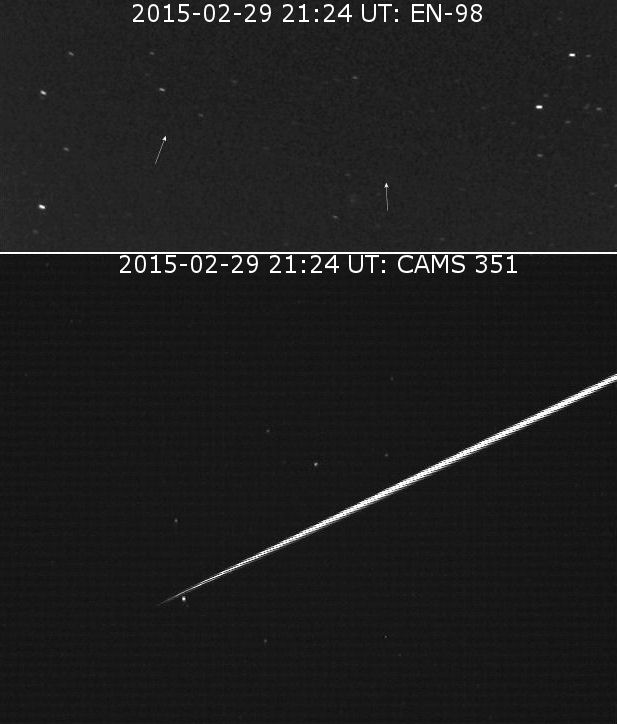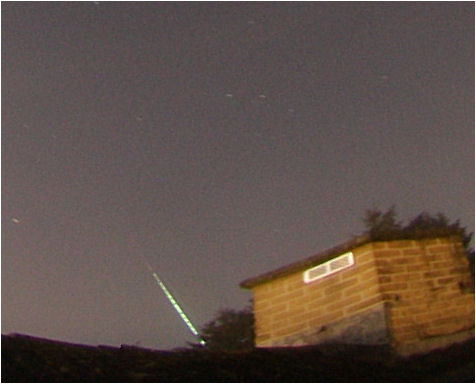I present an overview of my observing activities during the first three months of 2016. Unfortunately the first active meteor shower of the year, the Quadrantids, was lost due to the clouds.
The first night of 2016 that allowed observations was 8/9 January, observing at the flat roof of my dormer. Thanks to the clear sky conditions (LM 6.3) 37 meteors were counted. Highlights of this night were a blue magnitude +1 sporadic (SPO) meteor with multiple flares and a 3 seconds persistent train. Further a magnitude +3 Earth grazer was seen having a long track from Cepheus into Ursa Major. The meteor had a glitter tail of one degree. The best meteor however was a magnitude -3 December Leo Minorid (DLM) moving from Bootes to Corona Borealis at 02:08:45 UT. This meteor was also captured with my all sky camera.
The second night (17/18 January), was a long session from Goevenbeekse Heide (a heath about 1 km south of my home) with nearly five hours effective. A total of 47 meteors were counted, including 8 ANT and 3 DLM. The Anti Helion source showed some fine meteors, including a magnitude +1 and a magnitude 0. Temperatures went down to -8.4 C.
February 15/16 I could again observe from the Groevenbeekse Heide. A four-hour session produced 42 meteors which is a pretty good score in February. This was also thanks to the top conditions (according to Dutch standards) because the limiting magnitude got up to 6.4 with a dark sky background. 5 Anti Helions were seen, many faint meteors in the class +3 to +5, the brightest was a +1 SPO. Temperature again dropped to -8.0 C.
Another memorable night was 28/29 February. As the Moon rose at 23:30 UT I decided to started early. That was at 21:22 UT and already at 22:24:44 UT I saw the most beautiful meteor of this session. A yellow -2 SPO with a big wake moved very slowly from Gemini through Cancer to Leo. The meteor was captured with both my all sky camera and CAMS camera (351).
 Picture: combined image of the bright meteor of Februari 28, 2016 at 21:24:44 UT.
Picture: combined image of the bright meteor of Februari 28, 2016 at 21:24:44 UT.
Also during the night 12/13 March, a beautiful meteor was seen, an orange magnitude 0 with a short wake. It moved slowly from the Big Dipper to Serpens and lasted three seconds. This meteor was captured with my CAMS 351 camera. In total I could observe for 32 hours, resulting in 263 visual meteors. see table 1 for the results.
| Date | Location | Period UT | T.eff | Lm | ANT | DLM | QUA | SPO | TOT | Remarks | |
| 08/09-1-2016 | 52.2 n, 5.4 e | 0:05 | 3:05 | 3,00 | 6,28 | 3 | 2 | 3 | 29 | 37 | @home, Ermelo, -3 DLM |
| 17/18-1-2016 | 52.2 n, 5.4 e | 1:15 | 6:10 | 4,92 | 6,38 | 8 | 3 | ~ | 36 | 47 | @Groevenbeekse Heide |
| 18/19-1-2016 | 52.2 n, 5.4 e | 2:00 | 4:05 | 2,08 | 6,28 | 1 | 3 | ~ | 14 | 18 | @home, Ermelo |
| 12/13-2-2016 | 52.2 n, 5.4 e | 0:30 | 2:45 | 2,25 | 6,27 | 2 | ~ | ~ | 13 | 15 | @home, Ermelo |
| 15/16-2-2016 | 52.2 n, 5.4 e | 1:26 | 5:30 | 4,05 | 6,39 | 5 | ~ | ~ | 37 | 42 | @Groevenbeekse Heide |
| 16/17-2-2016 | 52.2 n, 5.4 e | 2:23 | 5:31 | 3,12 | 6,32 | 2 | ~ | ~ | 23 | 25 | @Groevenbeekse Heide |
| 27/28-2-2016 | 52.2 n, 5.4 e | 20:50 | 22:52 | 2,03 | 6,17 | 1 | ~ | ~ | 6 | 7 | @home, Ermelo |
| 28/29-2-2016 | 52.2 n, 5.4 e | 21:22 | 23:46 | 2,40 | 6,35 | 4 | ~ | ~ | 11 | 15 | @home, Ermelo |
| 04/05-3-2016 | 52.2 n, 5.4 e | 1:48 | 2:52 | 1,07 | 6,30 | 0 | ~ | ~ | 6 | 6 | @home, Ermelo |
| 12/13-3-2016 | 52.2 n, 5.4 e | 1:22 | 4:25 | 3,05 | 6,26 | 4 | ~ | ~ | 21 | 25 | @Groevenbeekse Heide |
| 13/14-3-2016 | 52.2 n, 5.4 e | 2:15 | 4:25 | 2,17 | 6,17 | 1 | ~ | ~ | 13 | 14 | @home, Ermelo |
| 15/16-3-2016 | 52.2 n, 5.4 e | 1:12 | 3:15 | 2,02 | 6,29 | 1 | ~ | ~ | 11 | 12 | @home, Ermelo |
| 12 sessions | 32,16 | 32 | 8 | 3 | 220 | 263 | |||||
Table 1: overview of my observing activities
All Sky camera EN-98
My all sky camera is a Canon EOS 40D equipped with a Sigma 4.5mm F2.8 EX DC Circular Fisheye HSM lens. This is placed in a wooden box. A convex front lens (which is continuously heated by three heating resistors) protects the lens from moisture. For speed determination there is a rotating sector in front of the lens. It produces 8,333 breaks per second. The all sky camera captured seven fireballs during this period. The brightest one was that of March 17, 2016 03:16:57 UT (the famous St. Patricks Day fireball over England), which was photographed trough the branches of the trees in the west. A detailed report can be read here: https://www.emeteornews.net/st-patricks-day-fireball-united-kingdom/ ). A second very bright fireball was photographed on March 25, 2016 at 23:00 UT, it appeared over Belgium and has been captured by several all sky cameras in the Benelux. Read to learn more about this fireball here: https://www.emeteornews.net/fireball-captured-dutch-sky-stations-fripon-france/

Picture: first half of the fireball of March 25, 2016 at 23:00 UT.


Koen,
Very nice summary of the “off season” for meteors. Your dedication during these slow and cold nights is to be admired! But as you have proven, even this period of the year can provide good results to those who make the effort.
Keep up the good work!
Bob
Thank you for your kind words Bob, I really appreciate it!
Best wishes,
Koen